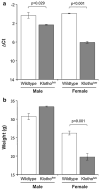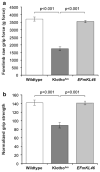Decline in muscle strength and running endurance in klotho deficient C57BL/6 mice
- PMID: 24030242
- PMCID: PMC3851892
- DOI: 10.1007/s10522-013-9447-2
Decline in muscle strength and running endurance in klotho deficient C57BL/6 mice
Abstract
Alpha klotho (known as klotho) is a multifunctional protein that may be linked to age-associated decline in tissue homeostasis. The original klotho hypomorphic (klotho (hm) ) mouse, produced on a mixed C57BL/6 and C3H background, is short lived and exhibits extensive aging-like deterioration of several body systems. Differently, klotho (hm) mice on a pure C57BL/6 background do not appear sickly nor die young, which has permitted us to gain insight into the effect of klotho deficiency in adult life. First, analyzing klotho transcript levels in the kidney, the main site of klotho production, we demonstrated a 71-fold decline in klotho (hm) females compared to wildtype females versus only a 4-fold decline in mutant males. We then examined the effect of klotho deficiency on muscle-related attributes in adult mice, focusing on 7-11 month old females. Body weight and forelimb grip strength were significantly reduced in klotho (hm) mice compared to wildtype and klotho overexpressing mice. The female mice were also subjected to voluntary wheel running for a period of 6 days. Running endurance was markedly reduced in klotho (hm) mice, which exhibited a sporadic running pattern that may be characteristic of repeated bouts of exhaustions. When actually running, klotho (hm) females ran at the same speed as wildtype and klotho overexpressing mice, but spent about 65 % less time running compared to the other two groups. Our novel results suggest an important link between klotho deficiency and muscle performance. This study provides a foundation for further research on klotho involvement as a potential inhibitor of age-associated muscle deterioration.
Figures




References
-
- Allen RE, Boxhorn LK. Inhibition of skeletal muscle satellite cell differentiation by transforming growth factor-beta. J Cell Physiol. 1987;133:567–572. - PubMed
-
- Arden N, Spector T. Genetic influences on muscle strength, lean body mass, and bone mineral density: a twin study. J Bone Miner Res. 1997;12:2076–2081. - PubMed
-
- Brack AS, Bildsoe H, Hughes SM. Evidence that satellite cell decrement contributes to preferential decline in nuclear number from large fibres during murine age-related muscle atrophy. J Cell Sci. 2005;118:4813–4821. - PubMed
Publication types
MeSH terms
Substances
Grants and funding
LinkOut - more resources
Full Text Sources
Other Literature Sources
Molecular Biology Databases
Miscellaneous

